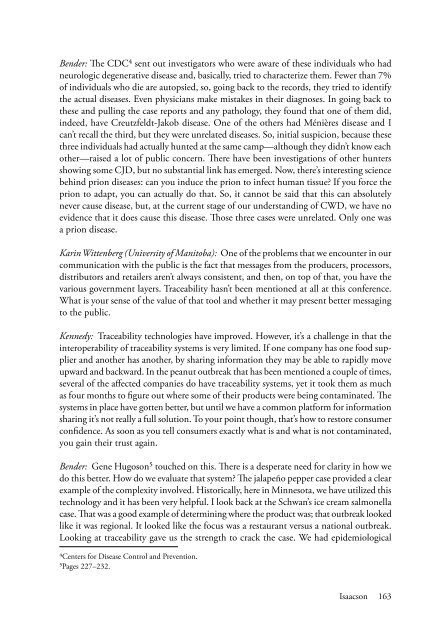Food Security - National Agricultural Biotechnology Council ...
Food Security - National Agricultural Biotechnology Council ...
Food Security - National Agricultural Biotechnology Council ...
- No tags were found...
Create successful ePaper yourself
Turn your PDF publications into a flip-book with our unique Google optimized e-Paper software.
Bender: The CDC4 sent out investigators who were aware of these individuals who hadneurologic degenerative disease and, basically, tried to characterize them. Fewer than 7%of individuals who die are autopsied, so, going back to the records, they tried to identifythe actual diseases. Even physicians make mistakes in their diagnoses. In going back tothese and pulling the case reports and any pathology, they found that one of them did,indeed, have Creutzfeldt-Jakob disease. One of the others had Ménières disease and Ican’t recall the third, but they were unrelated diseases. So, initial suspicion, because thesethree individuals had actually hunted at the same camp—although they didn’t know eachother—raised a lot of public concern. There have been investigations of other huntersshowing some CJD, but no substantial link has emerged. Now, there’s interesting sciencebehind prion diseases: can you induce the prion to infect human tissue? If you force theprion to adapt, you can actually do that. So, it cannot be said that this can absolutelynever cause disease, but, at the current stage of our understanding of CWD, we have noevidence that it does cause this disease. Those three cases were unrelated. Only one wasa prion disease.Karin Wittenberg (University of Manitoba): One of the problems that we encounter in ourcommunication with the public is the fact that messages from the producers, processors,distributors and retailers aren’t always consistent, and then, on top of that, you have thevarious government layers. Traceability hasn’t been mentioned at all at this conference.What is your sense of the value of that tool and whether it may present better messagingto the public.Kennedy: Traceability technologies have improved. However, it’s a challenge in that theinteroperability of traceability systems is very limited. If one company has one food supplierand another has another, by sharing information they may be able to rapidly moveupward and backward. In the peanut outbreak that has been mentioned a couple of times,several of the affected companies do have traceability systems, yet it took them as muchas four months to figure out where some of their products were being contaminated. Thesystems in place have gotten better, but until we have a common platform for informationsharing it’s not really a full solution. To your point though, that’s how to restore consumerconfidence. As soon as you tell consumers exactly what is and what is not contaminated,you gain their trust again.Bender: Gene Hugoson5 touched on this. There is a desperate need for clarity in how wedo this better. How do we evaluate that system? The jalapeño pepper case provided a clearexample of the complexity involved. Historically, here in Minnesota, we have utilized thistechnology and it has been very helpful. I look back at the Schwan’s ice cream salmonellacase. That was a good example of determining where the product was; that outbreak lookedlike it was regional. It looked like the focus was a restaurant versus a national outbreak.Looking at traceability gave us the strength to crack the case. We had epidemiological4Centers for Disease Control and Prevention.5Pages 227–232.Isaacson163















